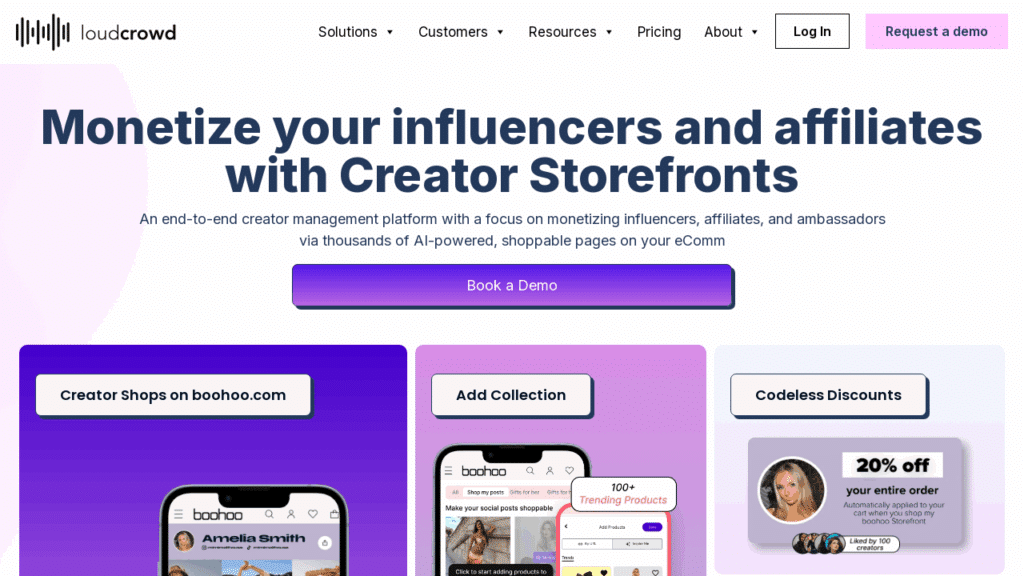In today’s digital landscape, the mix of social media influence with e-commerce has resulted in a powerful new revenue stream that astute businesses are hurrying to exploit. LoudCrowd, a dedicated platform, is at the vanguard of this transformation, revolutionising how businesses leverage creator partnerships with their groundbreaking Creator Shopfront technology. This in-depth review delves into LoudCrowd’s technological capabilities, investigates its unique approach to influencer monetisation, and evaluates how it stacks up against competitors in the increasingly congested creative economy software market.
What Is LoudCrowd? Understanding the Platform’s Core Technology
LoudCrowd positions itself as an end-to-end creator management platform specifically designed to monetize influencers, affiliates, and brand ambassadors through AI-powered, shoppable pages directly integrated with e-commerce websites. Unlike traditional affiliate marketing solutions that rely primarily on discount codes or basic tracking links, LoudCrowd’s foundation is built on the concept of “Creator Storefronts” – personalized, branded landing pages that live natively on a brand’s e-commerce site.
The platform’s architecture is designed to bridge the gap between social media engagement and e-commerce conversion, creating a seamless pathway that maintains brand control while empowering creators with customization capabilities. This approach addresses a fundamental challenge in influencer marketing: converting social media followers into actual customers through a friction-reduced buying experience.
Technical Capabilities and Integration Framework
One of LoudCrowd’s most impressive technical achievements is its integration flexibility. The platform can be implemented across virtually any e-commerce environment – from popular solutions like Shopify, WooCommerce, and Magento to completely custom-built storefronts. This versatility stems from LoudCrowd’s API-first approach and template-based implementation strategy.
The integration process follows a streamlined workflow:
-
Template Creation – Brands develop a single template that powers hundreds or thousands of co-branded landing pages, requiring minimal development resources
-
Creator Invitation – The platform facilitates onboarding creators through automated invitation systems
-
Personalization Layer – Creators can customize their storefronts with curated product collections and user-generated content
-
Analytics Integration – The system connects with existing tracking infrastructure for comprehensive attribution
What makes this implementation particularly impressive is the minimal technical debt it creates. According to LoudCrowd, brands can deploy these storefronts in as little as one week, making it an unusually lightweight enterprise integration compared to many martech solutions that require months of development work.
AI-Powered Functionality and Performance Enhancement
The “AI-powered” aspect of LoudCrowd’s platform appears to center around several key functionalities:
-
Automated Product Recommendation – The system can suggest optimal products for different creator audiences based on performance data
-
UGC Integration – Intelligent content curation tools that help identify and showcase the most effective creator-generated assets
-
Collection Creation – AI assistance in building product collections that maximize conversion potential
-
Performance Optimization – Automated testing and refinement of storefront elements to increase conversion rates
These AI capabilities serve to enhance not just the creation of storefronts but their ongoing optimization. This represents a significant advancement over static affiliate programs that lack dynamic adaptation to performance metrics.
User Experience Analysis: Brand vs. Creator Perspective
From a brand perspective, LoudCrowd provides a comprehensive dashboard for managing creator relationships, tracking performance, and measuring ROI. The interface centralizes multiple aspects of creator management that would otherwise require separate specialized tools:
-
Influencer recruitment and management
-
Campaign creation and tracking
-
Commission structure configuration
-
Performance analytics
-
Payment processing
For creators, the platform offers an intuitive interface for customizing their storefronts without requiring technical expertise. Creators can:
-
Select featured products
-
Create themed collections
-
Incorporate their social content
-
Track their performance and earnings
-
Access marketing tools to promote their storefronts
This dual-focused user experience ensures both brands and creators can efficiently navigate their respective workflows without unnecessary complexity – a critical factor in achieving widespread adoption among influencers who typically resist overly complicated technical requirements.
Comparative Analysis: How LoudCrowd Stacks Up Against Alternatives
LoudCrowd vs. LTK (Previously LikeToKnow.it)
While LTK has established itself as a dominant player in influencer monetization, its approach fundamentally differs from LoudCrowd’s. LTK creates a separate shopping destination that pulls consumers away from brand websites, whereas LoudCrowd keeps the entire shopping experience within the brand’s ecosystem. This distinction has significant implications:
-
Traffic Ownership: LoudCrowd keeps traffic on the brand’s site, while LTK diverts it to their platform
-
Competitive Environment: LTK exposes consumers to competing brands; LoudCrowd maintains brand exclusivity
-
Data Collection: LoudCrowd provides first-party data directly to brands; LTK maintains primary data ownership
-
Margin Protection: LoudCrowd typically offers more favorable economics by eliminating third-party commissions
LoudCrowd vs. Shopify Collabs
Shopify’s native solution for influencer collaboration offers integration convenience for Shopify merchants but lacks the depth of LoudCrowd’s specialized features:
-
Platform Limitation: Shopify Collabs only works with Shopify stores, while LoudCrowd is platform-agnostic
-
Storefront Capabilities: Shopify Collabs offers basic product sharing; LoudCrowd provides full-featured personalized storefronts
-
Analytics Depth: LoudCrowd offers more sophisticated performance tracking and attribution
-
Creator Management: LoudCrowd provides more comprehensive tools for managing creator relationships
LoudCrowd vs. TikTok Shop
As social platforms develop native shopping experiences, TikTok Shop represents a direct competitive approach to social commerce:
-
Platform Control: TikTok Shop keeps transactions within TikTok; LoudCrowd keeps them on brand websites
-
Commission Structure: TikTok Shop typically takes a higher percentage; LoudCrowd allows brands to set their own terms
-
Brand Experience: LoudCrowd maintains brand aesthetic and experience; TikTok Shop standardizes the shopping interface
-
Discovery: TikTok Shop may offer better discovery of new creators; LoudCrowd focuses on maximizing existing relationships
Case Study Analysis: Real-World Performance Metrics
LoudCrowd’s effectiveness is perhaps best illustrated through its documented results with partner brands:
-
Revival Rugs: Implementation of Creator Storefronts resulted in 680% higher conversion rates compared to standard site traffic
-
Melinda Maria: Generated $80,000 monthly in affiliate sales with a 37x ROI and a creator CPM of just $1.40
-
Unnamed Beauty Brand: Achieved a 26% conversion rate on traffic coming through Creator Storefronts
-
Fashion Brand: Reported a 76% decrease in customer acquisition costs through Ambassador Storefronts
These metrics reflect the platform’s ability to transform social influence into tangible e-commerce performance – addressing the attribution gap that has historically plagued influencer marketing initiatives.
Implementation Requirements and Technical Considerations
For brands considering LoudCrowd implementation, several technical prerequisites should be evaluated:
-
E-commerce Platform Compatibility: While LoudCrowd works with most systems, integration complexity may vary
-
Tracking Infrastructure: Existing attribution systems need to be compatible with LoudCrowd’s tracking capabilities
-
Creator Database Structure: Organizations with existing creator programs need to ensure smooth data migration
-
Commission Processing Capabilities: Financial systems must accommodate LoudCrowd’s payment workflows
-
Resource Allocation: Despite minimal development requirements, brands should allocate resources for template design and program management
LoudCrowd offers white-glove onboarding services and dedicated strategic support to navigate these considerations, which helps mitigate potential integration challenges.
Pricing Model and ROI Evaluation
While LoudCrowd doesn’t publicly disclose its pricing structure on its website, the platform appears to follow a SaaS model with pricing likely scaled to brand size and implementation scope. Prospective clients are directed to request demonstrations for customized pricing information.
From an ROI perspective, LoudCrowd positions its value proposition around several key metrics:
-
Increased conversion rates from social traffic
-
Higher average order values through curated collections
-
Improved creator retention and participation
-
Reduced reliance on paid social advertising
-
Enhanced first-party data collection
When evaluating potential return, brands should consider not just direct sales attribution but also the efficiency gained from centralizing creator management functions that might otherwise require multiple specialized tools.
Key Strengths and Limitations
Strengths:
-
Owned Channel Creation: Establishes brand-controlled social commerce pathways
-
Integration Flexibility: Works with virtually any e-commerce platform
-
Creator Experience: Offers intuitive tools that encourage creator participation
-
Attribution Clarity: Provides clear tracking of influencer-driven sales
-
Brand Consistency: Maintains brand experience throughout the purchase journey
Limitations:
-
Creator Discovery: Less focused on helping brands find new creators compared to some alternatives
-
Content Creation Tools: Fewer native content production capabilities than comprehensive influencer platforms
-
Social Platform Limitations: Less integrated with in-platform shopping features compared to native social commerce solutions
-
Implementation Requirements: Requires some level of technical integration compared to fully third-party solutions
Future Development and Industry Positioning
LoudCrowd appears positioned at the intersection of several evolving digital marketing trends:
-
The shift toward first-party data collection in the post-cookie era
-
Growing brand disillusionment with social platforms’ monetization models
-
Increasing sophistication in influencer marketing attribution
-
The rise of “creator economy” business models
As these trends accelerate, LoudCrowd’s approach of creating owned social commerce channels will likely gain additional relevance for brands seeking greater control over their digital customer acquisition strategies.
Expert Assessment: Who Should Consider LoudCrowd?
Based on this technical analysis, LoudCrowd appears particularly well-suited for:
-
D2C E-commerce Brands: Companies selling directly to consumers with established social media presence
-
Brands with Existing Creator Relationships: Organizations looking to better monetize current influencer partnerships
-
Multi-Channel Retailers: Businesses seeking to unify their approach to influencer marketing across platforms
-
Performance-Focused Marketing Teams: Teams prioritizing measurable ROI from influencer investments
The platform may be less optimal for:
-
Early-Stage Brands: Companies still establishing basic e-commerce operations
-
Discovery-Focused Programs: Brands primarily seeking to identify new influencers rather than optimize existing relationships
-
Content Production Priorities: Organizations more focused on content creation than conversion optimization
Final Analysis: Is LoudCrowd Worth the Investment?
For brands serious about transforming social influence into measurable e-commerce revenue, LoudCrowd offers a compelling technical solution that addresses many longstanding challenges in the creator marketing space. Its approach of creating native, brand-controlled shopping experiences powered by creator influence represents a significant advancement over traditional affiliate models.
The platform’s demonstrated results with major brands across multiple verticals suggest its methodology delivers measurable performance improvements rather than simply streamlining existing processes. For marketing teams struggling with influencer attribution or seeking to reduce dependency on increasingly expensive paid social channels, LoudCrowd’s Creator Storefront approach warrants serious consideration.
As social commerce continues its rapid evolution, LoudCrowd’s position at the intersection of creator relationships and e-commerce functionality places it at the forefront of an increasingly important digital marketing discipline – making it a technology worth watching even for organizations not yet ready for implementation.

